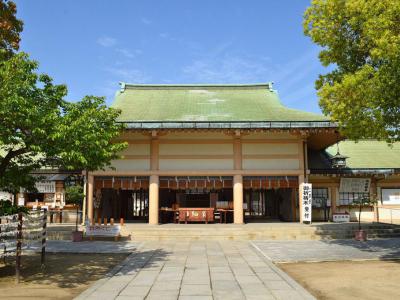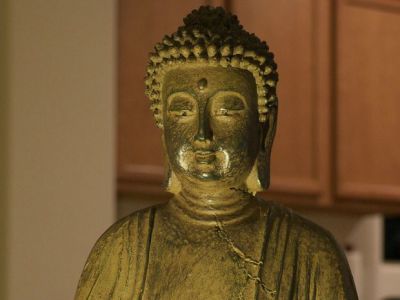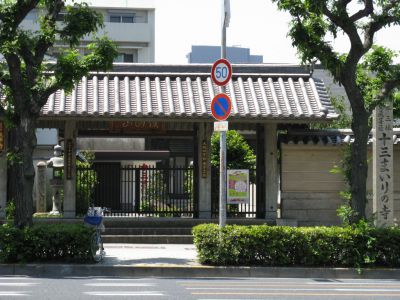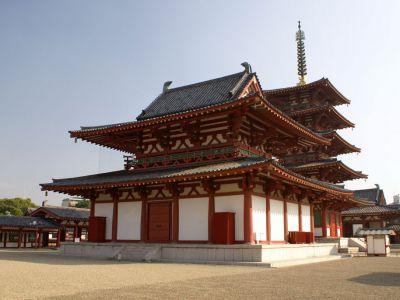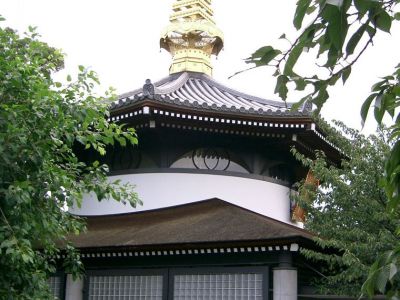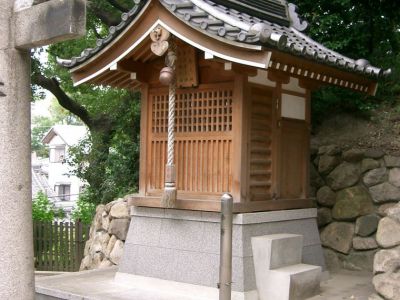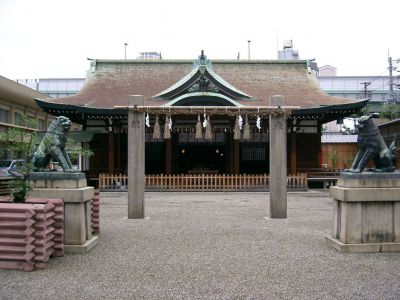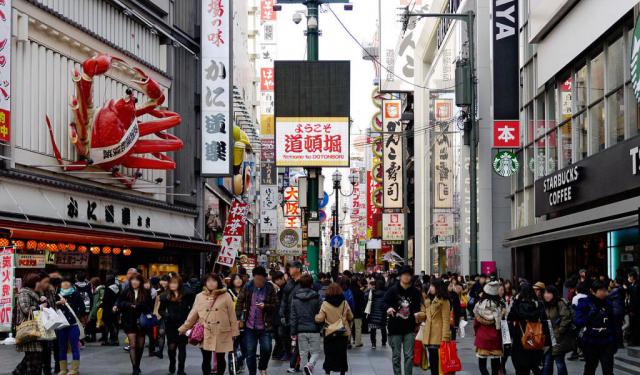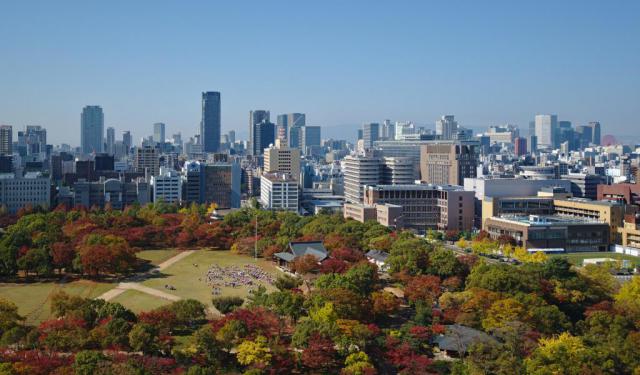
Tennoji Shrines and Temples Walking Tour (Self Guided), Osaka
Osaka is Japan’s third largest city. It is therefore not at all surprising to find within its boundaries many religious sites. Tennoji, a district of Osaka steeped in cultural and historical significance, is particularly rich in terms of beautiful temples and shrines.
Ikukunitama Shrine, nestled amidst the city's clamor, is a dedication to the deity Ikukunitama-no-mikoto, offering comfort to those seeking inner peace. Kisshoji Temple, with its traditional architecture, invites visitors to explore its tranquil gardens and experience the teachings of Buddhism. Jusan-mairi-no-tera, or Taiheiji Temple, is a sacred site where 13-year-old boys and girls come as part of their coming-of-age ritual.
Shitennoji Temple, founded in 593 AD, holds the distinction of being Japan's oldest Buddhist temple and serves as a symbol of Osaka's spiritual heritage. Isshinji Temple, renowned for its artistic and cultural treasures, showcases the intricate beauty of Japanese Buddhism.
At the same time, Yasui Shrine is a haven for those seeking blessings for good relationships and reconciliation, while Imamiya Ebisu Shrine draws visitors with its lively festivals celebrating Ebisu, the god of commerce and prosperity.
As you explore Tennoji's shrines and temples, you'll encounter not only the historical and cultural aspects of Japan but also a sense of tranquility amidst the bustling city life. Whether you're a tourist or local, these sacred locations offer a unique opportunity to connect with Japan's rich spiritual traditions and find solace in their peaceful surroundings.
Ikukunitama Shrine, nestled amidst the city's clamor, is a dedication to the deity Ikukunitama-no-mikoto, offering comfort to those seeking inner peace. Kisshoji Temple, with its traditional architecture, invites visitors to explore its tranquil gardens and experience the teachings of Buddhism. Jusan-mairi-no-tera, or Taiheiji Temple, is a sacred site where 13-year-old boys and girls come as part of their coming-of-age ritual.
Shitennoji Temple, founded in 593 AD, holds the distinction of being Japan's oldest Buddhist temple and serves as a symbol of Osaka's spiritual heritage. Isshinji Temple, renowned for its artistic and cultural treasures, showcases the intricate beauty of Japanese Buddhism.
At the same time, Yasui Shrine is a haven for those seeking blessings for good relationships and reconciliation, while Imamiya Ebisu Shrine draws visitors with its lively festivals celebrating Ebisu, the god of commerce and prosperity.
As you explore Tennoji's shrines and temples, you'll encounter not only the historical and cultural aspects of Japan but also a sense of tranquility amidst the bustling city life. Whether you're a tourist or local, these sacred locations offer a unique opportunity to connect with Japan's rich spiritual traditions and find solace in their peaceful surroundings.
How it works: Download the app "GPSmyCity: Walks in 1K+ Cities" from Apple App Store or Google Play Store to your mobile phone or tablet. The app turns your mobile device into a personal tour guide and its built-in GPS navigation functions guide you from one tour stop to next. The app works offline, so no data plan is needed when traveling abroad.
Tennoji Shrines and Temples Walking Tour Map
Guide Name: Tennoji Shrines and Temples Walking Tour
Guide Location: Japan » Osaka (See other walking tours in Osaka)
Guide Type: Self-guided Walking Tour (Sightseeing)
# of Attractions: 7
Tour Duration: 2 Hour(s)
Travel Distance: 3.5 Km or 2.2 Miles
Author: alice
Sight(s) Featured in This Guide:
Guide Location: Japan » Osaka (See other walking tours in Osaka)
Guide Type: Self-guided Walking Tour (Sightseeing)
# of Attractions: 7
Tour Duration: 2 Hour(s)
Travel Distance: 3.5 Km or 2.2 Miles
Author: alice
Sight(s) Featured in This Guide:
- Ikukunitama Shrine
- Kisshoji Temple
- Jusan-mairi-no-tera (Taiheiji Temple)
- Shitennoji Temple
- Isshinji Temple
- Yasui Shrine
- Imamiya Ebisu Shrine
1) Ikukunitama Shrine
The Ikukunitama Shrine is dedicated to the Shinto deities, Ikushima-no-kami and Tarushima-no-kami. It is the venue for many important festivals in Osaka.
The Ikukunitama Shrine was first built on the site that is now the Osaka Castle. It was razed to the ground during the battle of Ishiyama in 1580. It was relocated to its present site when Hideyoshi Toyotomi chose the site to build Osaka Castle. After two years, the main pavilion was built in an innovative style called Ikutama-zukuri. All pavilions were under one roof with three gables in this type of structural design. The shrine suffered damage during the World War II bombings and the present shrine is a recent one made of concrete with a copper roof.
The important festivals that take place in the Ikukunitama Shrine are the Oharae ceremony that takes place on the 30th of June. The rituals are performed to drive away bad luck and disease on this day. The Ikutama Summer Festival takes place here in July and the Osaka Takigi Noh drama festival takes place in August. The most popular event is the Hikohachi festival held on the first Saturday of September in honor of Hikohachi Yonezawa, the first exponent of the Kamikata Rakugo Storytelling technique. Exponents of Raguko tell stories in the unique style to an enthralled audience. Besides the event, the grounds of the shrine are converted into a small fair with many interesting activities for children.
The Ikukunitama Shrine was first built on the site that is now the Osaka Castle. It was razed to the ground during the battle of Ishiyama in 1580. It was relocated to its present site when Hideyoshi Toyotomi chose the site to build Osaka Castle. After two years, the main pavilion was built in an innovative style called Ikutama-zukuri. All pavilions were under one roof with three gables in this type of structural design. The shrine suffered damage during the World War II bombings and the present shrine is a recent one made of concrete with a copper roof.
The important festivals that take place in the Ikukunitama Shrine are the Oharae ceremony that takes place on the 30th of June. The rituals are performed to drive away bad luck and disease on this day. The Ikutama Summer Festival takes place here in July and the Osaka Takigi Noh drama festival takes place in August. The most popular event is the Hikohachi festival held on the first Saturday of September in honor of Hikohachi Yonezawa, the first exponent of the Kamikata Rakugo Storytelling technique. Exponents of Raguko tell stories in the unique style to an enthralled audience. Besides the event, the grounds of the shrine are converted into a small fair with many interesting activities for children.
2) Kisshoji Temple
The Kisshoji Temple is a Buddhist temple managed by the Soto Sect of Buddhism. It is dedicated to the 47 Ronin who avenged the death of their master Asano Naganori.
The Kisshoji Temple was established by a Zen Buddhist Priest called Dogen. It was a favorite resting place of the Samurai Lord Asano Naganori. He was forced to commit Seppuku or ritual suicide during a meeting of Samurai Lords in Edo when he attacked his rival Kira who taunted him. His 47 followers avenged the unfair death of their master, killed Kira and committed Sepukku. At the time of Asano’s death, the priest at the temple, Juken was his dear friend. Juken converted the temple into a shrine for Asano and the 47 Ronin.
The Kisshoji Temple has stone sculptures of Asano and the 47 loyal Ronin. These are post World War II replacements of the original wooden statues. Although their graves are in the Sengaku-ji Temple in Tokyo, their nails and hair were buried here. The walls around the temple are lined with cherry trees. On December 14th, the day the Ronnin took their revenge, a festival is held here annually. Young boys dress up like the Ronnin and the temple serves a buckwheat noodle dish called Uchiiri Soba to visitors.
The Kisshoji Temple was established by a Zen Buddhist Priest called Dogen. It was a favorite resting place of the Samurai Lord Asano Naganori. He was forced to commit Seppuku or ritual suicide during a meeting of Samurai Lords in Edo when he attacked his rival Kira who taunted him. His 47 followers avenged the unfair death of their master, killed Kira and committed Sepukku. At the time of Asano’s death, the priest at the temple, Juken was his dear friend. Juken converted the temple into a shrine for Asano and the 47 Ronin.
The Kisshoji Temple has stone sculptures of Asano and the 47 loyal Ronin. These are post World War II replacements of the original wooden statues. Although their graves are in the Sengaku-ji Temple in Tokyo, their nails and hair were buried here. The walls around the temple are lined with cherry trees. On December 14th, the day the Ronnin took their revenge, a festival is held here annually. Young boys dress up like the Ronnin and the temple serves a buckwheat noodle dish called Uchiiri Soba to visitors.
3) Jusan-mairi-no-tera (Taiheiji Temple)
The Taiheiji Temple dedicated to Jusan Mairi is located within the Shittenoji Yuhigiaka complex in Osaka. The Shittenoji Yuhigiaka is the oldest temple complex in Japan. The Taiheiji Temple is managed by the Soto sect of Zen Buddhism.
The Jusan-mairi-no-tera (Taiheiji Temple) was built as part of the Shittenoji Yuhigiaka complex at first. When the Shittenoji complex reduced in size after a civil war, this temple remained intact. It was given to the Shingon sect of Zen Buddhism in 1555 and its name was changed to the Ryushoji Temple. The Buddhist priest Ginetsu dedicated the temple to the Soto Sect in 1663 and they continue to manage the temple till today.
The principle deity at the Jusan-mairi-no-tera (Taiheiji Temple) is the Kokuzo Bosatsu, the Bodhisattva of wisdom and prosperity. It is famous for a traditional ceremony where children who turn 13 visit and seek the blessings of the deity on March 13th and April 13th annually. They pray for wisdom in their future endeavors at the temple. The ceremony is called Chiemairi or Wisdom Visit and was a popular tradition during the Edo Era. The temple also has shrines for deities of handicrafts and skill in art. People bring their tools and utensils and Buddhist rites are performed to bless them.
The Jusan-mairi-no-tera (Taiheiji Temple) was built as part of the Shittenoji Yuhigiaka complex at first. When the Shittenoji complex reduced in size after a civil war, this temple remained intact. It was given to the Shingon sect of Zen Buddhism in 1555 and its name was changed to the Ryushoji Temple. The Buddhist priest Ginetsu dedicated the temple to the Soto Sect in 1663 and they continue to manage the temple till today.
The principle deity at the Jusan-mairi-no-tera (Taiheiji Temple) is the Kokuzo Bosatsu, the Bodhisattva of wisdom and prosperity. It is famous for a traditional ceremony where children who turn 13 visit and seek the blessings of the deity on March 13th and April 13th annually. They pray for wisdom in their future endeavors at the temple. The ceremony is called Chiemairi or Wisdom Visit and was a popular tradition during the Edo Era. The temple also has shrines for deities of handicrafts and skill in art. People bring their tools and utensils and Buddhist rites are performed to bless them.
4) Shitennoji Temple
The Shitennoji Temple is the first and therefore the oldest Buddhist Temple in Japan. It is located in the Tennoji-ku area of Osaka.
The Shitennoji Temple was built in 593 by Prince Shotoku who was instrumental in the rapid spread of Buddhism in Japan. He commissioned the temple to emphasize the importance of Buddhist chanting and meditation among the people. The buildings have suffered damage and have been rebuilt several times after the death of Prince Shotoku. The most recent renovation of the structure was in 1963. It remains the most popular among Buddhist shrines in the city and is the venue for many important festivals.
The Shitennoji Temple is built in honor of four heavenly Kings or the Shitteno. Four shrines dedicated to each God are placed in each direction. The shrine for Masunaga is in the South, Tamon in the North, Jokoku in the East and Hirome in the West. The complex consists of a five story pagoda, a golden hall that serves as a shrine of Prince Shotoku, a turtle pond and a garden called Gokuraku-jodo representing the Buddhist Paradise. The temple has from its foundations represented the power and prosperity of Japan. A major festival is held here on the 14th of January every year.
The Shitennoji Temple was built in 593 by Prince Shotoku who was instrumental in the rapid spread of Buddhism in Japan. He commissioned the temple to emphasize the importance of Buddhist chanting and meditation among the people. The buildings have suffered damage and have been rebuilt several times after the death of Prince Shotoku. The most recent renovation of the structure was in 1963. It remains the most popular among Buddhist shrines in the city and is the venue for many important festivals.
The Shitennoji Temple is built in honor of four heavenly Kings or the Shitteno. Four shrines dedicated to each God are placed in each direction. The shrine for Masunaga is in the South, Tamon in the North, Jokoku in the East and Hirome in the West. The complex consists of a five story pagoda, a golden hall that serves as a shrine of Prince Shotoku, a turtle pond and a garden called Gokuraku-jodo representing the Buddhist Paradise. The temple has from its foundations represented the power and prosperity of Japan. A major festival is held here on the 14th of January every year.
5) Isshinji Temple
The Isshinji Temple is a Buddhist temple managed by the Jodo Shu sect of Zen Buddhism. It is famous for its Okotsubutsu or Buddha statue made from the cremated remains of human beings.
The Isshinji Temple is located near the ancient Shittenoji temple of Osaka. It was established by Honen the founder of the Jodo Shu sect as a small hermitage in 1185. It was a popular place of pilgrimage and the Emperor Goshirakawa came here to pray by repeating the name of the Buddha while facing the setting sun in the hope of being blessed with a happy and peaceful life. The land around the temple was donated by the wife of warlord Hideyoshi Tokotomi and it served as the headquarters of Togugawa Leyasu during the battle of Osaka.
The Buddha statues within the temple are made of the remains of common people whose families left their corpses here. The purpose of turning them into statues was to show respect for the dead by making them objects of worship. A statue was made every ten years and before the Second World War there were 12 Okotsubutsu in the temple. Six were destroyed by the World War II bombardments. The present temple is a recent one with a modern temple gate and Hiso-den or main hall designed by the present head priest of Isshinji Temple.
The Isshinji Temple is located near the ancient Shittenoji temple of Osaka. It was established by Honen the founder of the Jodo Shu sect as a small hermitage in 1185. It was a popular place of pilgrimage and the Emperor Goshirakawa came here to pray by repeating the name of the Buddha while facing the setting sun in the hope of being blessed with a happy and peaceful life. The land around the temple was donated by the wife of warlord Hideyoshi Tokotomi and it served as the headquarters of Togugawa Leyasu during the battle of Osaka.
The Buddha statues within the temple are made of the remains of common people whose families left their corpses here. The purpose of turning them into statues was to show respect for the dead by making them objects of worship. A statue was made every ten years and before the Second World War there were 12 Okotsubutsu in the temple. Six were destroyed by the World War II bombardments. The present temple is a recent one with a modern temple gate and Hiso-den or main hall designed by the present head priest of Isshinji Temple.
6) Yasui Shrine
The Yasui Shrine is dedicated to two important monks called Sukuna-hikona-no-kami and Sugawara-no-Michizane. It also has a monument to the brave warrior Sanada Yukimura who died fighting the shoguns at the site.
The year of construction of the shrine is unknown. Some believe that it was established in 942 when Sugawara-no-Michizane rested here on his way to Kyushu. Another theory is that there was a shrine at the location as early as the year 590. It is also dedicated to Sukuna-hikona-no-kami a Buddhist monk whose name appears in many Japanese historical legends. Sanada Yukimura a hero of the battle of Osaka came to the temple as a last resort and died here fighting bravely.
Visitors need to climb a steep stone stairway to reach the Yasui Shrine after passing a carved stone gate. It is a small peaceful stone structure built on the rim of a small hill. The Kanshizume-no-I or Well of Nerve Calming is located within the complex. The waters of the well are said to be one of the seven best waters in the city and is sacred because it was drunk by Sugawara-no-Michizane. There is also an imposing sculpture of the well loved war hero Yukimura Sanada on a pedestal. People from all over Japan come here to pay their respects to the hero and write their wishes on offerings made to his statue.
The year of construction of the shrine is unknown. Some believe that it was established in 942 when Sugawara-no-Michizane rested here on his way to Kyushu. Another theory is that there was a shrine at the location as early as the year 590. It is also dedicated to Sukuna-hikona-no-kami a Buddhist monk whose name appears in many Japanese historical legends. Sanada Yukimura a hero of the battle of Osaka came to the temple as a last resort and died here fighting bravely.
Visitors need to climb a steep stone stairway to reach the Yasui Shrine after passing a carved stone gate. It is a small peaceful stone structure built on the rim of a small hill. The Kanshizume-no-I or Well of Nerve Calming is located within the complex. The waters of the well are said to be one of the seven best waters in the city and is sacred because it was drunk by Sugawara-no-Michizane. There is also an imposing sculpture of the well loved war hero Yukimura Sanada on a pedestal. People from all over Japan come here to pay their respects to the hero and write their wishes on offerings made to his statue.
7) Imamiya Ebisu Shrine
The Imamiya Ebisu Shrine is dedicated to Ebessan, the God of business and prosperity. It is very popular in Osaka which is known as the business and trade capital of Japan.
The Imamiya Ebisu Shrine was commissioned by Prince Shotoku in the year 600. The main festival of the shrine that is celebrated in January attracts pilgrims from across Japan. They come here to pray for commercial prosperity. Ebessan the main deity at the shrine is depicted carrying a fishing rod and a large fish symbolizing abundance and wealth. He is one of the seven Gods of good luck according to traditional Japanese belief.
The Imamiya Ebisu Shrine comes alive during the annual festival. The festival takes place between the 8th and 12th of January annually. Young ladies give bamboo stalks called Fuku Musume to visitors with lucky charms attached to them and they pray to the deity for prosperity and business success through the year. The grounds of the shrine have many stalls selling food and the Rice wine called Sake at this time. Traditional folk dances are also performed. On Toka Ebisu or the tenth day, a colorful parade takes place and Geisha and local celebrities are borne on palanquins. Geisha dances, rice cake making and other performing arts also take place on this auspicious day.
The Imamiya Ebisu Shrine was commissioned by Prince Shotoku in the year 600. The main festival of the shrine that is celebrated in January attracts pilgrims from across Japan. They come here to pray for commercial prosperity. Ebessan the main deity at the shrine is depicted carrying a fishing rod and a large fish symbolizing abundance and wealth. He is one of the seven Gods of good luck according to traditional Japanese belief.
The Imamiya Ebisu Shrine comes alive during the annual festival. The festival takes place between the 8th and 12th of January annually. Young ladies give bamboo stalks called Fuku Musume to visitors with lucky charms attached to them and they pray to the deity for prosperity and business success through the year. The grounds of the shrine have many stalls selling food and the Rice wine called Sake at this time. Traditional folk dances are also performed. On Toka Ebisu or the tenth day, a colorful parade takes place and Geisha and local celebrities are borne on palanquins. Geisha dances, rice cake making and other performing arts also take place on this auspicious day.
Walking Tours in Osaka, Japan
Create Your Own Walk in Osaka
Creating your own self-guided walk in Osaka is easy and fun. Choose the city attractions that you want to see and a walk route map will be created just for you. You can even set your hotel as the start point of the walk.
Osaka Shopping and Dining Walking Tour
As well as being an exciting Western-style city full of cool entertainment and cultural attractions, Osaka is a great place for shopping. The appealing range of shopping venues here includes covered arcades, malls, thoroughfares, and more. Let's take a closer look at some of these locations.
Shinsaibashi Shopping Street is a bustling retail district renowned for its upscale stores and... view more
Tour Duration: 1 Hour(s)
Travel Distance: 2.2 Km or 1.4 Miles
Shinsaibashi Shopping Street is a bustling retail district renowned for its upscale stores and... view more
Tour Duration: 1 Hour(s)
Travel Distance: 2.2 Km or 1.4 Miles
Osaka Castle Park Walking Tour
Sprawling on the south bank of the Ōkawa (Yodo) River, Osaka Castle Park occupies a vast territory in the heart of Osaka. The second largest park in the city, it covers nearly two square kilometers with lots of greenery, sports and other facilities.
Apart from being an urban public venue, the area is also a historical site, dating back more than half a millennium. Back in 1496, during the... view more
Tour Duration: 1 Hour(s)
Travel Distance: 2.9 Km or 1.8 Miles
Apart from being an urban public venue, the area is also a historical site, dating back more than half a millennium. Back in 1496, during the... view more
Tour Duration: 1 Hour(s)
Travel Distance: 2.9 Km or 1.8 Miles
Osaka Introduction Walking Tour
Osaka is the third largest city and second largest metropolitan area in Japan. The city has a long history that dates to the earliest days of Japan. In fact, it is thought that the area was the location where the first inhabitants of the island settled. Archaeological evidence shows there were settlers in the area more than 2,000 years ago.
The beginning of the third century brought many more... view more
Tour Duration: 2 Hour(s)
Travel Distance: 4.9 Km or 3 Miles
The beginning of the third century brought many more... view more
Tour Duration: 2 Hour(s)
Travel Distance: 4.9 Km or 3 Miles
The Most Popular Cities
/ view all
